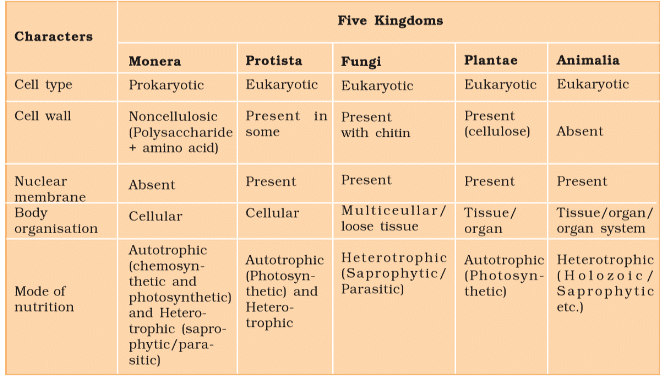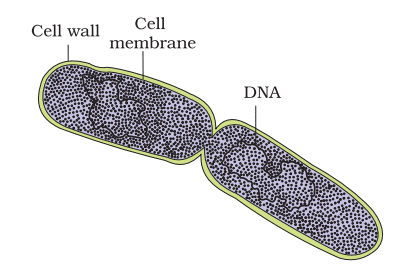Biological Classification Chapter Notes | Biology Class 11 - NEET PDF Download
| Table of contents |

|
| What is Biological Classification? |

|
| 1. Kingdom Monera |

|
| 2. Kingdom Protista |

|
| 3. Kingdom Fungi |

|
| 4. Kingdom Plantae |

|
| 5. Kingdom Animalia |

|
| Viruses, Viriods, Prions and Lichens |

|
What is Biological Classification?
The process of grouping together various organisms according to their similarities, dissimilarities and phylogenetic descent is known as biological classification.
- There have been various attempts to classify organisms. The earliest was by Aristotle, who classified plants into herbs shrubs and trees. He classified animals into two groups, based on the presence and absence of red blood. Linnaeus gave the Two Kingdom system of classification and divided living organisms into Plantae and Animalia.
- R.H. Whittaker proposed the Five Kingdom system of classification and classified organisms, based on cellular structure, complexity, mode of nutrition, phylogenetic relationship and ecological role performed by them.
- Whittaker divided organisms into Monera, Protista, Fungi, Plantae and Animalia.
 Five Kingdom Classification by Whittaker
Five Kingdom Classification by Whittaker

- Previous Classifications: Earlier systems grouped diverse organisms, such as bacteria, algae, fungi, and various plants, primarily based on the presence of a cell wall.
- Unified Characteristics: The unifying feature of the earlier classifications was the cell wall, leading to the grouping of prokaryotic and eukaryotic organisms together despite their differences.
- Kingdom Protista has brought together Chlamydomonas, Chlorella (earlier placed in Algae within Plants and both having cell walls) with Paramoecium and Amoeba (which were earlier placed in the animal kingdom which lack cell wall). It has put together organisms which, in earlier classifications, were placed in different kingdoms
- Over time, an attempt has been made to evolve a classification system which reflects not only the morphological, physiological and reproductive similarities, but is also phylogenetic, i.e., is based on evolutionary relationships.
1. Kingdom Monera
- This group includes all kinds of bacteria, having a prokaryotic cell.
- The cell does not contain a nucleus.
 Kingdom Monera: Bacteria Cell Structure
Kingdom Monera: Bacteria Cell Structure
- There are different shapes of bacteria present; spherical- cocci, rod-shaped- bacillus, comma- vibrio and spiral- spirilla.
- They mainly reproduce by fission, spore formation under unfavorable conditions, and also by DNA transfer from one bacterium cell to another.
- Mycoplasma lack the cell wall and are the smallest cell to survive without oxygen.
- Archaebacteria- These bacteria are present in the harshest environmental conditions such as salty, marshy and in hot springs. They are known as halophiles, methanogens, thermoacidophiles, respectively. Methanogens are present in the gut of ruminants and produce biogas.
Eubacteria- These are true bacteria and have a rigid cell wall and motile organisms have flagella.
A. Photosynthetic Autotrophs
They include Cyanobacteria (Blue-green Algae). They have chlorophylls and carotenoids. They are unicellular, filamentous or colonial and the body is covered by a mucilaginous sheath. Nostoc and Anabaena have heterocysts, where they can fix atmospheric nitrogen.
 A filamentous blue-green algae – NostocB. Chemosynthetic Autotrophs
A filamentous blue-green algae – NostocB. Chemosynthetic Autotrophs
They play an important role in recycling nutrients. They get the required energy for ATP generation from the oxidation of various inorganic substances such as ammonia, nitrates and nitrites.
C. Heterotrophic
There is a wide variety of heterotrophic bacteria. They act as a decomposer. They are used for various purposes such as nitrogen-fixing, curd and antibiotics production. Many bacteria are pathogen causing various diseases of plants and animals, e.g. citrus canker, tetanus, typhoid, cholera.
Bacteria Reproduction
- Bacteria primarily reproduce through a process known as fission, which involves the division of a single cell into two identical daughter cells.
- Under unfavorable conditions, some bacteria can produce spores as a means of survival. Spores are resistant structures that can withstand harsh environments.
- Bacteria also engage in a form of sexual reproduction by transferring DNA from one bacterium to another. This process is a primitive form of genetic exchange and contributes to genetic diversity.
 A dividing bacterium
A dividing bacterium
Mycoplasma
- Mycoplasma are unique organisms that lack a cell wall, making them distinct from other bacteria. They are the smallest known living cells and have the ability to survive without oxygen.
- Some species of mycoplasma are pathogenic, meaning they can cause diseases in animals and plants.
2. Kingdom Protista
- The group includes unicellular eukaryotes.
- A photosynthetic protista is a link between plants, animals and Fungi
- They contain a well-defined nucleus and other membrane-bound cell organelles.
 Diversity of Protists
Diversity of Protists
(i) Chrysophytes
- Include diatoms and desmids (golden algae).
- They are mostly photosynthetic and have indestructible cell wall due to the presence of silica.
- The cell wall makes two thin overlapping shells, which fit like a soapbox on the outer surface.
- Diatomaceous earth is the deposit of the cell wall that gets accumulated. It is used for filtration and polishing.
(ii) Dinoflagellates
 Dinoflagellate
Dinoflagellate
- They are photosynthetic and marine.
- They are found in many colours like yellow, green, red, blue, and brown, according to the pigment present.
- Stiff cellulose plates are present on the cell wall.
- Red dinoflagellates (Example: Gonyaulax) multiply rapidly and cause red tide.
- Many dinoflagellates emit blue-green light and are bioluminescent.
(iii) Euglenoids
 Euglena
Euglena
- They are photosynthetic flagellated protist.
- They are a link between plants and animals. They perform photosynthesis but lack a cell wall.
- The characteristic feature is the presence of pellicle, a protein-rich layer, which makes their body flexible.
- In the absence of sunlight, they feed on small organisms and behave as a heterotrophs.
(iv) Slime moulds
 Slime mould
Slime mould
- They are saprophytic protists feeding on organic materials from decaying twigs and leaves.
- Aggregation of slime moulds is called plasmodium, which they form under favourable conditions.
- Under unfavourable conditions, fruiting bodies containing spores develop at the tip of the plasmodium.
- These spores can survive for very long under adverse conditions and have true walls.
(v) Protozoans
- The group contains all the unicellular, eukaryotic, heterotrophs, which are parasites or predators.
- These are divided into 4 major groups:
- Amoeboid- They are characterised by the presence of pseudopodia, which are used for movement and catching of prey, e.g. Amoeba. Marine amoeboids have silica shells. Some of the amoeboids are parasites, e.g. Entamoeba histolytica causes amoebic dysentery.
- Flagellated- They are characterised by the presence of flagella. Some of them are parasites causing various diseases, e.g Trypanosoma causes sleeping sickness.
- Ciliated- They have thousands of cilia on their body surface. The coordinated movement of cilia helps in steering the water having food into the gullet (body cavity, which opens outside the body surface), e.g. Paramoecium.
 Paramoecium
Paramoecium - Sporozoans- They are characterised by the formation of spores, which is the infectious stage, e.g. Plasmodium.
3. Kingdom Fungi
- Fungi are cosmopolitan and found everywhere.
- They are heterotrophic and get the nutrients by absorption.
- Their cell wall is made up of chitin or fungal cellulose.
- Their mode of nutrition is saprophytic, parasitic or symbiotic and the main food reserve is glycogen.
- Vegetative reproduction is by fragmentation, budding or fission.
- Asexual reproduction is by spores formation such as conidia, zoospores, sporangiospores.
- Sexual reproduction is by oospore, ascospore or basidiospore formation in distinct fruiting bodies.
- In sexual reproduction, plasmogamy (fusion of protoplasm) is followed by karyogamy (fusion of nuclei).
- In basidiomycetes and ascomycetes, plasmogamy is not immediately followed by karyogamy, resulting in a distinct dikaryon (n+n) cell having 2 nuclei per cell.
- Fungi are divided into four major classes on the basis of types and mode of spore formation and the structure of mycelium.


Some Important Fungi
- Yeast- used in fermentation to make cheese, bread, beer.
- Penicillium- antibiotics source.
- Puccinia- causes wheat rust.
- Ustilago- causes smut disease.
- Symbionts- Lichens (symbiotic association of fungi with algae), Mycorrhiza (symbiotic association of fungi with roots of green plants).
- Rhizopus- the bread mould.
- Albugo- the parasitic fungi on mustard.
- Neurospora- extensively used in genetic and biochemical work.
- Truffles and Morels- edible and are considered a delicacy.
- Agaricus- edible as well as poisonous species.
 Examples of Fungi
Examples of Fungi
4. Kingdom Plantae
- Mostly autotrophic, chlorophyll-containing, eukaryotic organisms.
- Characterised by the presence of rigid cell wall made up of cellulose.
- Some plants are partially heterotrophic such as Insectivorous (Venus flytrap, Bladderwort) and parasites (Cuscuta).
- Life cycle of plants has two distinct phases – the diploid sporophytic and the haploid gametophytic – that alternate with each other.
- This phenomenon is called alternation of generation.

5. Kingdom Animalia
- Animals are classified on the basis of common fundamental features like the cellular arrangement, symmetry of the body, presence or absence of the coelom, specific features of the digestive, circulatory and reproductive system
- All the heterotrophic, eukaryotic and multicellular organisms are included in the Kingdom Animalia.
- They lack a cell wall.
- They follow a definite growth pattern and grow into adults that have a definite shape and size.
- Higher forms show elaborate sensory and neuromotor mechanism. Most of them are capable of locomotion

Viruses, Viriods, Prions and Lichens
Viruses
- Dmitri Ivanowsky gave the name “virus” to the causal organism of tobacco mosaic disease (TMV).
- Beijerinek called the fluid extracted from diseased plants of tobacco, “Contagium vivum fluidum” and observed it as being infectious to healthy plants.
 Tobacco Mosaic Virus (TMV)
Tobacco Mosaic Virus (TMV)
- Stanley crystallised TMV (tobacco mosaic virus) for the first time.
- They are acellular containing nucleic acid core (either DNA or RNA), which is surrounded by a protein coat called the capsid.
- Viruses use the host machinery to multiply inside the host cell, they exist in a crystalline form outside the host cell.
- They are obligate parasite and cause various diseases in plants and animals, e.g. common cold, AIDS, polio, mumps, measles, chickenpox, etc. in animals and various mosaic diseases in plants such as tobacco, cucumber, tomato, etc. leaf curling, yellowing of vein, etc.
- Viruses that infect plants have single-stranded RNA.
- Bacteriophages, viruses infecting bacteria have double-stranded DNA.
 Bacteriophage
Bacteriophage
Viroids
- They are the smallest infectious agents found. They consist of nucleic acid but lack a protein coat.
- Diener discovered viroids as a causative agent of potato spindle tuber disease, that was a free RNA.
Prions
- They contain abnormally folded proteins and have a size similar to viruses.
- They can change the shape of normal proteins by transmitting their misfolded proteins.
- They cause many neurodegenerative diseases, e.g. bovine spongiform encephalopathy (BSE) in cattle and Cr-Jacob disease in humans.
Lichens
- They are a symbiotic, mutually beneficial association of algae (phycobiont) and fungi (mycobiont). The alga is autotrophic and provides food, whereas the fungus provides protection and shelter.
- Lichens do not grow in polluted areas so they are a good pollution indicator.
|
150 videos|401 docs|136 tests
|
FAQs on Biological Classification Chapter Notes - Biology Class 11 - NEET
| 1. What are the main characteristics of Kingdom Monera? |  |
| 2. How do organisms in Kingdom Protista differ from those in other kingdoms? |  |
| 3. What roles do fungi play in the ecosystem? |  |
| 4. What are the defining features of Kingdom Plantae? |  |
| 5. How do viruses, viroids, and prions differ from the five kingdoms of life? |  |
















